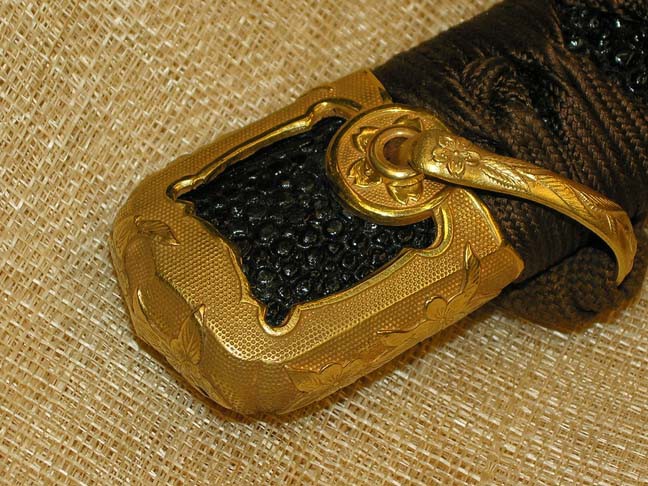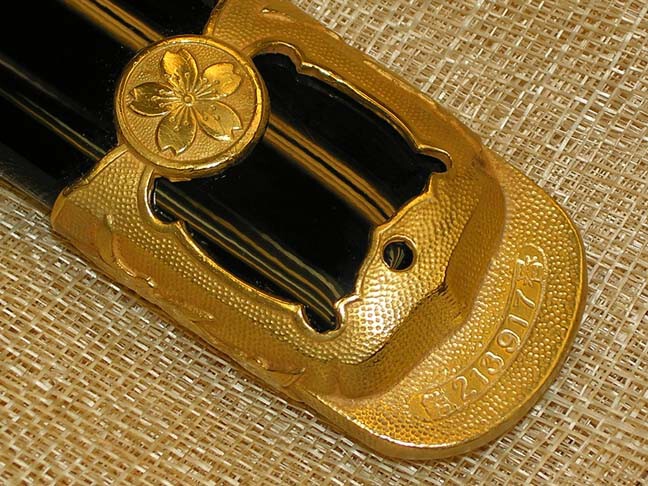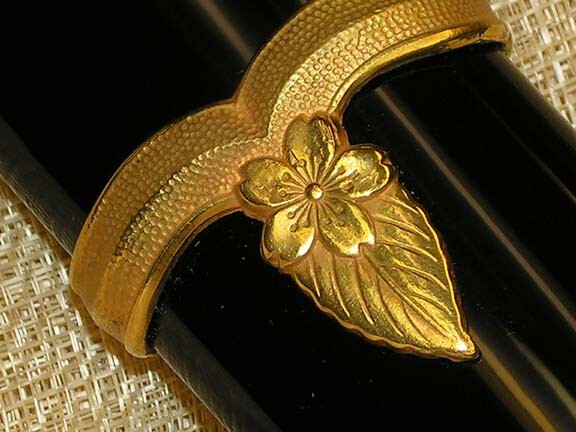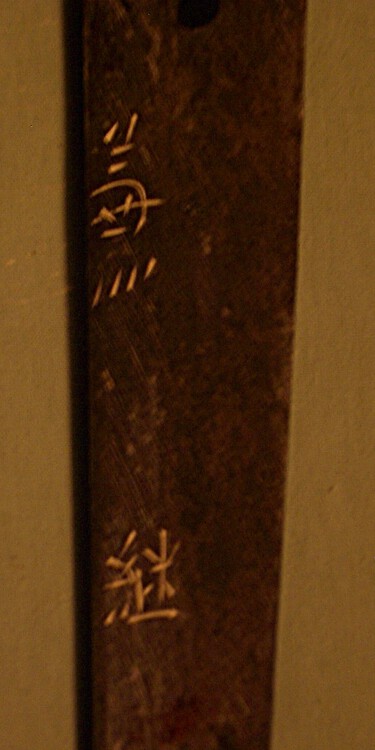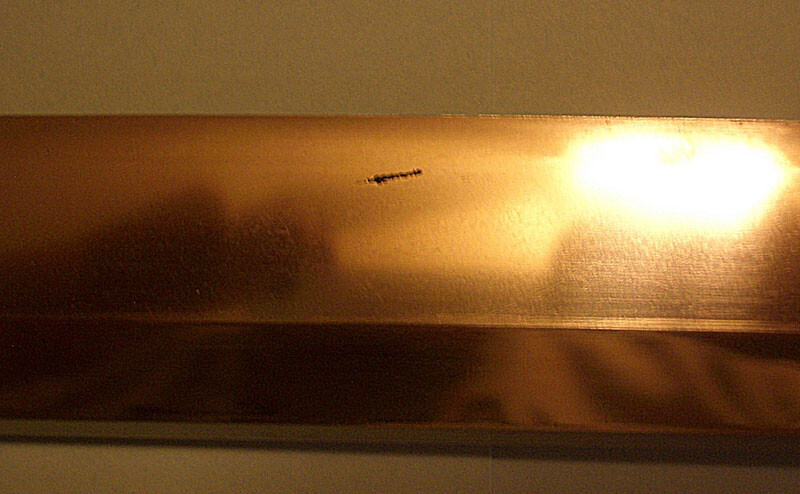-
Posts
124 -
Joined
-
Last visited
Everything posted by patrick7813
-

Kai Gunto restoration project
patrick7813 replied to patrick7813's topic in Military Swords of Japan
Yes, I’m very pleased with its appearance. Fred did contact me during the process indicating the ishizuke was damaged and was uncertain it could be salvaged. If he couldn’t repair it sufficiently, he would replace it with one from his collection. -
All I have a WW2 period Kai gunto with a handmade, water tempered blade forged by Noguchi Yasumitsu in excellent condition. There are no stamps or arsenal marks on the nakago. Unfortunately, the koshirae was in poor condition and deteriorated to the point of being extremely unattractive. Because I wanted to display this sword, I contacted Fred Lohman about creating a new koshirae with as many of the original fittings salvaged as possible. The result was a new tsuka with blackened rayskin and new mid military brown colored Ito, a new black lacquered wooden saya and new gold gilding on all the original metal fittings (e.g., kabuto-gane, sarute, menuki, fuchi, chu-ha, koi-guchi, ashi, obi-tori, semegane and ishizuke). The original seppa and tsuba were restored to their original finish (shakudo - blue black). This restoration project required about 7 months elapsed time to complete to Fred’s level of satisfaction. I received the finished product yesterday. It certainly exceeds my expectations and was, to use an old cliché, well worth the wait. I applaud Fred for his patience with my endless inquires about completion. It has now assumed the central focus point of my displayable collection. Included are a few pictures for everyone to enjoy. Cheers,
-
Malcolm Thanks for the very thorough and detailed research. Not knowing much about Japanese feudal society marriage customs and family traditions, I could imagine that an arranged marriage could result in a combined kamon of those 2 families. That’s a plausible explanation. I’ve located the 2 books you cited on Amazon US as well as a few others there that I’ve now ordered. Thanks too for that tip. This is turning into a very interesting little research project. Thanks to everyone else that also pointed me in the research direction. I learn more each day. Cheers,
-
Thanks. If it is a family crest, I'm trying to determine which family. I haven't been able to locate any symbol or crest remotely similar. Regards,
-
All I have a shin gunto that’s mounted with an older arsenal made blade from what I believe was a kyu-gunto and the officer chose to have it remounted when the new type 94/98 patterns were approved. The tsuka is reminiscent of an older tachi style due to its curvature and it also has the older style pierced tsuba. The person from whom I acquired it indicated that David McDonald replaced the Ito and repaired the rayskin on the Tsuka. The saya is the smooth lacquer version and has battle damage. Its leather combat cover has matching damage in the same location. Apparently the blade was not housed in the saya when the damage occurred because it does not have any corresponding damage. Here’s my issue. It has, on the kabuto-gane in a location that would normally hold a kamon, another type of symbol (see pictures). I’m uncertain what it represents and am looking for opinions. Cheers,
-

Polisher signature in strange location
patrick7813 replied to patrick7813's topic in Military Swords of Japan
Chris, thanks for this insight and the translation. I learn more each day. Regards, -
All I have a shin gunto with a blade forged by Masayasu. Other than his 2 character signature there are no other markings or stamps on the nakago. However, it is also signed with the 2 character polisher’s name (as I have been told) on the shinogi-ji, adjacent to the machi and under the habaki (see picture). I have never seen a signature in this location. I have not yet attempted to translate it. Can anyone shed any other information on this placement? Cheers and regards,
-
Thanks for the confirmation. I must be getting more adept at this although it’s still a struggle. However, some do fall into place easier than others. Cheers,
-
Hi All This is from a gunto mounted blade in my possession. I'm trying to learn how to do translations myself and am seeking some verification on this attempt. I've translated the mei as Kanetsugu and the date as July 1944. Thanks for any feedback. Cheers,
-

Looking for a WW2 shin gunto tsuka restoration service
patrick7813 replied to patrick7813's topic in Military Swords of Japan
Thanks for the heads-up Grey. Today, I received my restored tsuka (new but antiqued same' and period appropriate color Ito plus maintenance to the wooden core) back from David McDonald. Great looking result and very sturdy. I highly recommend his services to everyone. Cheers, -

Navy Gunto for $4k? For fittings?
patrick7813 replied to kaigunair's topic in Military Swords of Japan
I suspect it’s a combination of both the appearance of the blade and quality of the mounts, especially the rarity of the extended drag ishizuke. I’ve seen swords with that extended drag (both Navy and Army) command higher than normal prices. I will also add that I’ve seen many recent sword sales on eBay generate much higher prices ($3-$4k range, I suspect again based upon appearance IMHO), than the sword warrants especially given the non-exceptional smiths that forged the blades. Cheers, -
Hi George Most of the gunto mounted blades in my collection (about 20) are in the 68-69 cm range. Although, I do have a Star stamped blade that is 61.5 cm in length (kissaki to machi) that was discussed in some detail in another thread. I have another incoming where the length is 60 cm. I was intrigued by its short length and wanted to handle in person. The hamon is still visible in the now tempered portion of the new nakago but the yakiba has been de-edged so that it’s no longer sharp but otherwise has no visible evidence of de-tempering. Interestingly, the polish of this area, once I cleaned the gunk off, remains in better condition than the blade itself. Cheers and later,
-
Hi George Great insights, thank you. The measurement from the kissaki to the current (new) machi is 63.5 cm. The length from the kissaki to what would have been the original (old) machi (as best I determine since it’s obliterated) is 70.5 cm. BTW, the hamon extends into the new nakago about 3.8 cm. Also, I can distinctly see the "swell" of the old blade now into the nakago where the habaki binds. It’s very apparent when viewing the new nakago top down. I would be very interested if you learn more about this Sukefusa..... Best regards,
-
Hi George Thanks for the observations; they’re invaluable in expanding my knowledge. I can see where the yasuri wasn’t refilled and the hamon definitely now extends into the nakago. Can you offer a reason why the blade would be machi okuri? The current tsuka/tsuba/seppa combination aligns with the ana closest the machi area. Yes, the habaki does move slightly to a position on the nakago and then binds just about where it’s in the picture and can understand what you’re stating but I can also see “gunk” inside it but again don’t want to force it. There is minor activity in the hamon but otherwise a medium, straight version, most likely water tempered, hence the presence of some activity. Unless I’m just missing some finer point, not unheard of in my continuing education. Best regards,
-
Thanks for the quick reply Mark. Unfortunately, I don't have F&G's Swordsmiths of Japan 1926-1945 (I've been trying to locate it for awhile but without success). Sukefusa isn't listed in Slough's and not on the Nihonto Club swordsmith index as a showa smith with that name but there are several others from earlier periods. Hum...... Agree with you on the economics of a polish, etc..... Thanks again and Cheers,
-
All I have a gunto mounted blade that I’m unsure if it’s an older forging than a Showato and possibly gendaito. I haven’t been able to translate the nakago 2 character signature (see picture). There are no arsenal stamps present. There is 1 small grain opening (see picture) near the machi and the blade has a visible hada, I believe itame. The hamon is chu-suguha. The blade does have a slight “wiggle” (nee bend) to it when looking down the mune. Also attached is a picture showing a full view of the nakago showing 2 Ana and the machi for reference. Unfortunately, the habaki must be clogged with I suspect cosmoline (the machi area was very greasy) as it can’t easily be removed from the nakago and I’m reluctant to force it. If someone can help translate the smith’s name that would be a great help in potentially determining its era of forging. Thanks for any assistance. Cheers,
-

Looking for a WW2 shin gunto tsuka restoration service
patrick7813 replied to patrick7813's topic in Military Swords of Japan
Thanks for the tip Brock (and conversely dissenting view KM). I'm developing nice working relationships with those previously recommended and believe I'm well set to move forward. Cheers to all, -

Looking for a WW2 shin gunto tsuka restoration service
patrick7813 replied to patrick7813's topic in Military Swords of Japan
John This is certainly one of many benefits to me of membership in the NMB. Discussions with and recommendations from members who know more than I do and have first hand experience and satisfaction with the work products of various service providers. As far as I'm concerned, that's invaluable. Thanks to both you and Grey for your separate recommendations as well as Jamie Dotson who also recommended Randy Black. Regards, -

Looking for a WW2 shin gunto tsuka restoration service
patrick7813 replied to patrick7813's topic in Military Swords of Japan
Thanks John. You're the second member to recommend Randy Black. I've sent him an email to discuss his options and capabilities as well as Dave McDonald (as recommend by Grey Doffin). Regards, -

Looking for a WW2 shin gunto tsuka restoration service
patrick7813 replied to patrick7813's topic in Military Swords of Japan
Thanks Grey. I have contacted him via email to discuss options and capabilities. Regards, -

Looking for a WW2 shin gunto tsuka restoration service
patrick7813 replied to patrick7813's topic in Military Swords of Japan
Yeah, just a little bit further (not much mind you but there's also that pesky Customs). Too bad! Thanks anyway, -
All Other than Fred Lohman, does anyone know who else provides a restoration service (applying new rayskin and the correct color silk Ito) for a shin gunto tsuka? I’m looking for someone closer to the US East Coast than Fred. I have a 1939 shin gunto was a near-mint blade by the 23rd generation Kanefusa where the rayskin on the tsuka is seriously eroded in many places and I want to replace it. Since the Ito must be removed to replace the rayskin, I'll have that replaced as well with a correct military brown color in silk. Thanks for any recommendations. Cheers,
-
Chris and Kevin Thank you. I respect your opinions and will follow your advice. I do see the area in the hamon near the kissaki where another opening could occur during polishing (as well as the potential for others currently unseen). It is regrettable since the blade appears otherwise beautiful, excepting these flaws. The mounts also appear in near- mint condition. Regards,
-
All I have an opportunity to acquire a shin gunto with an older, hand forged blade. The hamon appears as choji. The nagasa is 25 inches. The age or date is unknown (the nakago is bare). There are 2 ji-ware. About 2mm of the kissaki is missing. See pictures. Is this blade salvageable and worth the expense of a polish? Thanks for any thoughts and opinions. Cheers,
-

Removing black stains from Showato blade
patrick7813 replied to patrick7813's topic in Military Swords of Japan
Stephen Thanks, I was afraid of that. I don't feel the blade is worth the expense of a polish (even Fred Lohman's $800 one). Too bad, otherwise it's a very nice, attractive blade with an active hamon (gunome). Unfortunately, IMHO, the black stains ruin it's appearance. Cheers,




